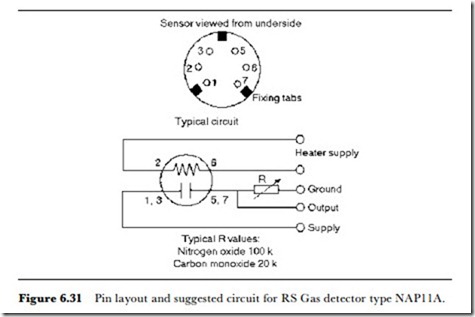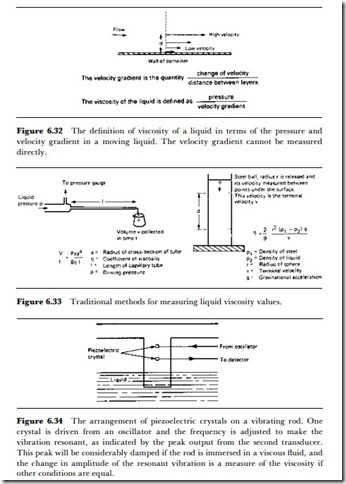Viscosity
The viscosity of a liquid or gas is the quantity that corresponds to friction
between solids, and which determines how much pressure will be needed to drive the liquid or gas through a pipe. In addition, some chemical reactions result in very marked changes in viscosity, so that sensing methods are needed for liquids that are static and not flowing. For almost all liquids, the viscosity, as measured by a coefficient of viscosity, decreases as the liquid is heated. For gases the reverse is true, and this is one reason why it is so much more difficult to deal with hot gas exhausts as compared to cold gas intakes.
Figure 6.32 shows the definition of the coefficient of viscosity in terms of the force that makes one layer of a liquid move faster than another does. This force cannot be measured directly, but from the definition we can calculate the amount of force needed to spin a solid cylinder in a liquid, the amount of pressure needed to deliver a given volume per second of liquid through a pipe, or the rate at which a dense sphere will fall through the liquid. The traditional methods of measuring viscosity are based on such principles (Figure 6.33), but none of them is appropriate for electronic purposes apart from the pressure difference method that can be important in the control of continuous flow processes.
Note that the methods of sensing liquid flow by means of the pressure difference across a restriction all assume that the viscosity of the liquid is constant – any change of viscosity will be read as a change of velocity. Electronic sensors for viscosity can make use of the damping of mechanical oscillations by a viscous liquid or gas. The principle is illustrated in Figure 6.34 which shows a plunger that can be vibrated by a piezoelectric transducer, and whose amplitude of vibration is sensed by another transducer. If this arrangement is part of an oscillating circuit, then the damping effect of a
liquid on the amplitude of oscillation will depend on the viscosity of the liquid. This can be sensed electrically as the amplitude of the signal from the receiving transducer.

